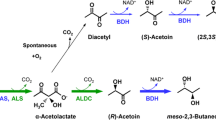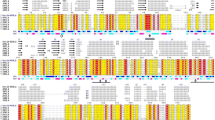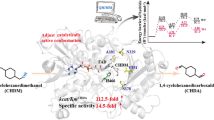Abstract
Herein, different dehydrogenases (DH) were characterized by applying a novel two-step enzyme assay. We focused on the NAD(P)+-dependent phenylacetaldehyde dehydrogenases because they produce industrially relevant phenylacetic acids, but they are not well studied due to limited substrate availability. The first assay step comprises a styrene oxide isomerase (440 U mg−1 protein) which allows the production of pure phenylacetaldehydes (>70 mmol L−1) from commercially available styrene oxides. Thereafter, a DH of interest can be added to convert phenylacetaldehydes in a broad concentration range (0.05 to 1.25 mmol L−1). DH activity can be determined spectrophotometrically by following cofactor reduction or alternatively by RP-HPLC. This assay allowed the comparison of four aldehyde dehydrogenases and even of an alcohol dehydrogenase with respect to the production of phenylacetic acids (up to 8.4 U mg−1 protein). FeaB derived from Escherichia coli K-12 was characterized in more detail, and for the first time, substituted phenylacetaldehydes had been converted. With this enzyme assay, characterization of dehydrogenases is possible although the substrates are not commercially available in sufficient quality but enzymatically producible. The advantages of this assay in comparison to the former one are discussed.




Similar content being viewed by others
Abbreviations
- adh/ADH:
-
Gene of/gene product aldehyde dehydrogenase
- adh-/ADH-CWB2:
-
Gene of/gene product aldehyde dehydrogenase of Gordonia rubripertincta CWB2
- ADH-Sc:
-
Aldehyde dehydrogenase of Saccharomyces cerevisiae
- AlDH-Sc:
-
Alcohol dehydrogenase of Saccharomyces cerevisiae
- DH:
-
Dehydrogenases
- feaB/FeaB:
-
Gene of/gene product phenylacetaldehyde dehydrogenase
- feaB-/FeaB-K-12:
-
Gene of/gene product phenylacetaldehyde dehydrogenase of Escherichia coli K-12
- PAD:
-
Phenylacetaldehyde dehydrogenase
- PMS:
-
Phenazine methosulfate
- SOI:
-
Styrene oxide isomerase of Rhodococcus opacus 1CP
- styC :
-
Gene of styrene oxide isomerase of Rhodococcus opacus 1CP
References
Sophos, N. A., Pappa, A., Ziegler, T. L., & Vasiliou, V. (2001). Aldehyde dehydrogenase gene superfamily: the 2000 update. Chemico-Biological Interactions, 130–132(1–3), 323–337.
Vasiliou, V., Pappa, A., & Petersen, D. R. (2000). Role of aldehyde dehydrogenases in endogenous and xenobiotic metabolism. Chemico-Biological Interactions, 129(1–2), 1–19.
Rodríguez-Zavala, J. S., Allali-Hassni, A., & Weiner, H. (2006). Characterization of E. coli tetrameric aldehyde dehydrogenases with atypical properties compared to other aldehyde dehydrogenases. Protein Science, 15(6), 1387–1396.
Shimizu, E., Ichise, H., Odawara, T., & Yorifuji, T. (1993). NADP-dependent phenylacetaldehyde dehydrogenase for degradation of phenylethylamine in Arthrobacter globiformis. Bioscience, Biotechnology, and Biochemistry, 57(5), 852–853.
Corkery, D. M., O’Connor, K. E., Buckley, C. M., & Dobson, A. D. W. (1994). Ethylbenzene degradation by Pseudomonas fluorescens strain CA-4. FEMS Microbiology Letters, 124(1), 23–27.
Ferrández, A., Prieto, M. A., García, J. L., & Díaz, E. (1997). Molecular characterization of PadA, a phenylacetaldehyde dehydrogenase from Escherichia coli. FEBS Letters, 406(1–2), 23–27.
Hartmans, S., Smits, J. P., van der Werf, M. J., Volkering, F., & de Bont, J. A. M. (1989). Metabolism of styrene oxide and 2-phenylethanol in the styrene-degrading Xanthobacter strain 124X. Applied and Environmental Microbiology, 55(11), 2850–2855.
Hartmans, S., Van der Werf, M. J., & de Bont, J. A. M. (1990). Bacterial degradation of styrene involving a novel flavin adenine dinucleotide-dependent styrene monooxygenase. Applied and Environmental Microbiology, 56(5), 1347–1351.
Parrott, S., Jones, S., & Cooper, R. A. (1987). 2-Phenylethylamine catabolism by Escherichia coli K12. Journal of General Microbiology, 133(2), 347–351.
Hirano, J.-I., Miyamoto, K., & Ohta, H. (2007). Purification and characterization of aldehyde dehydrogenase with a broad substrate specificity originated from 2-phenylethanol-assimilating Brevibacterium sp. KU1309. Applied Microbiology and Biotechnology, 76(2), 357–363.
Xu, F. (2005). Applications of oxireductases: recent progress. Industrial Biotechnology, 1(1), 38–50.
Brichac, J., Ho, K. K., Honzatko, A., Wang, R., Lu, X., Weiner, H., & Picklo, M. J. S. (2007). Enantioselective oxidation of trans-4-hydroxy-2-nonenal is aldehyde dehydrogenase isozyme and Mg2+ dependent. Chemical Research in Toxicology, 20(6), 887–895.
Oelschlägel, M., Heiland, C., Schlömann, M., & Tischler, D. (2015). Production of a recombinant membrane protein in an Escherichia coli strain for the whole cell biosynthesis of phenylacetic acids. Biotechnology Report, 7, 38–43.
Oelschlägel, M., Kaschabek, S. R., Zimmerling, J., Schlömann, M., & Tischler, D. (2015). Co-metabolic formation of substituted phenylacetic acids by styrene-degrading bacteria. Biotechnol Rep., 6, 20–26.
Carmona, M., Zamarro, M. T., Blázquez, B., Durante-Rodríguez, G., Juárez, J. F., Valderrama, J. A., Barragán, M. J. L., García, J. L., & Díaz, E. (2009). Anaerobic catabolism of aromatic compounds: a genetic and genomic view. Microbiology and Molecular Biology Reviews, 73(1), 71–133.
Sophos, N. A., & Vasiliou, V. (2003). Aldehyde dehydrogenase gene superfamily: the 2002 update. Chemico-Biological Interactions, 143–144, 5–22.
Chen, A., Ren, L., & Crudden, C. M. (1999). Catalytic asymmetric hydrocarboxylation and hydrohydroxymethylation. A two-step approach to the enantioselective functionalization of vinylarenes. The Journal of Organic Chemistry, 64(26), 9704–9710.
Corse, J. W., Jones, R. G., Soper, Q. F., Whitehead, C. W., & Behrens, O. K. (1948). Biosynthesis of penicillins. V. Substituted phenylacetic acid derivates as penicillin precursors. Journal of the American Chemical Society, 70(9), 2837–2843.
Douma, R. D., Deshmukh, A. T., de Jong, B. W., Seifar, R. M., Heijnen, J. J., & van Gulik, W. M. (2012). Novel insights in transport mechanisms and kinetics of phenylacetic acid and penicillin-G in Penicillium chrysogenum. Biotechnology Progress, 28(2), 337–348.
Ghorai, P., Kraus, A., Keller, M., Götte, C., Igel, P., Schneider, E., Schnell, D., Bernhardt, G., Dove, S., Zabel, M., Elz, S., Seifert, R., & Buschauer, A. (2008). Acylguanidines as bioisosteres of guanidines: NG-acylated imidazolylpropylguanidines, a new class of histamine H2 receptor agonists. Journal of Medicinal Chemistry, 51(22), 7193–7204.
Gualtieri, F., Conti, G., Dei, S., Giovannoni, M. P., Nannucci, F., Romanelli, M. N., Scapecchi, S., Teodori, E., Fanfani, L., Ghelardini, C., Giotti, A., & Bartolin, A. (1994). Presynaptic cholinergic modulators as potent cognition enhancers and analgesic drugs. 1. Tropic and 2-phenylpropionic acid esters. Journal of Medicinal Chemistry, 37(11), 1704–1711.
Hamdouchi, C., Sanchez-Martinez, C., Gruber, J., del Prado, M., Lopez, J., Rubio, A., & Heinz, B. A. (2003). Imidazo [1,2-b] pyridazines, novel nucleus with potent and broad spectrum activity against human picornaviruses: design, synthesis, and biological evaluation. Journal of Medicinal Chemistry, 46(20), 4333–4341.
Jiang, J., DeVita, R. J., Kumar, S., Mills, S. G., & Tschirret-Guth, R. A. (2010). United States Patent, US7683068, Merck Sharp & Dohme Corp., US.
Luo, Y., Li, Y., Qiu, K.-M., Lu, X., Fu, J., & Zhu, H.-L. (2011). Metronidazole acid acyl sulfonamide: a novel class of anticancer agents and potential EGFR tyrosine kinase inhibitors. Bioorganic & Medicinal Chemistry, 19(20), 6069–6076.
Milne, J. E., Storz, T., Colyer, J. T., Thiel, O. R., Seran, M. D., Larsen, R. D., & Murry, J. A. (2011). Iodide-catalyzed reductions: development of a synthesis of phenylacetic acids. The Journal of Organic Chemistry, 76(22), 9519–9524.
Pedemonte, N., Sonawane, N. D., Taddei, A., Hu, J., Zegarra-Moran, O., Suen, Y. F., Robins, L. I., Dicus, C. W., Willenbring, D., Nantz, M. H., Kurth, M. J., Galietta, L. J. V., & Verkman, A. S. (2005). Phenylglycine and sulfonamide correctors of defective F508 and G551D cystic fibrosis transmembrane conductance regulator chloride-channel gating. Molecular Pharmacology, 67(5), 1797–1807.
Pour, M., Spulák, M., Balsánek, V., Kunes, J., Kubanová, P., & Buchta, V. (2003). Synthesis and structure–antifungal activity relationships of 3-aryl-5-alkyl-2,5-dihydrofuran-2-ones and their carbanalogues: further refinement of tentative pharmacophore group. Bioorganic & Medicinal Chemistry, 11(13), 2843–2866.
Small, R. E. (1989). Diclofenac sodium. Clinical Pharmacy, 8(8), 545–558.
Wagner, R., Larson, D. P., Beno, D. W. A., Bosse, T. D., Darbyshire, J. F., Gao, Y., Gates, B. D., He, W., Henry, R. F., Hernadez, L. E., Hutchinson, D. K., Jiang, W. W., Kati, W. M., Klein, L. L., Koev, G., Kohlbrenner, W., Krueger, A. C., Liu, J., Liu, Y., Long, M. A., Maring, C. J., Masse, S. V., Middleton, T., Montgomery, D. A., Pratt, J. K., Stuart, P., Molla, A., & Kempf, D. J. (2009). Inhibitors of hepatitis C virus polymerase: synthesis and biological characterization of unsymmetrical dialkyl-hydroxynaphthalenoyl-benzothiadiazines. Journal of Medicinal Chemistry, 52(6), 1659–1669.
Zhu, Y.-J., Zhou, H.-T., Hu, Y.-H., Tang, J.-Y., Su, M.-X., Guo, Y.-J., Chen, Q.-X., & Liu, B. (2011). Antityrosinase and antimicrobial activities of 2-phenylethanol, 2-phenylacetaldehyde and 2-phenylacetic acid. Food Chemistry, 124(1), 298–302.
Fahlbusch, K.-G., Hammerschmidt, F.-J., Panten, J., Pickenhagen, W., Schatkowski, D., Bauer, K., Garbe, D., & Surburg, H. (2012). Flavors and fragrances (15th ed.). Weinheim: Wiley-VCH.
Taqui Khan, M. M., Halligudi, S. B., & Abdi, S. H. R. (1988). Carbonylation of benzyl chloride to phenylacetic acid and its ester using water-soluble Ru(III)-EDTA complex catalyst. Journal of Molecular Catalysis, 44(2), 179–181.
Tischler, D., & Kaschabek, S. R. (2012). Microbial degradation of xenobiotics. In S. N. Singh (Ed.), Microbial styrene degradation: from basics to biotechnology (pp. 67–99). Heidelberg: Springer.
Arias, S., Olivera, E. R., Arcos, M., Naharro, G., & Luengo, J. M. (2008). Genetic analyses and molecular characterization of the pathways involved in the conversion of 2-phenylethylamine and 2-phenylethanol into phenylacetic acid in Pseudomonas putida U. Environmental Microbiology, 10(2), 413–432.
Hanlon, S. P., Hill, T. K., Flavell, M. A., Stringfellow, J. M., & Cooper, R. A. (1997). 2-Phenylethylamine catabolism by Escherichia coli K-12: gene organization and expression. Microbiology, 143(2), 513–518.
Bestetti, G., Di Gennaro, P., Colmegna, A., Ronco, I., Galli, E., & Sello, G. (2004). Characterization of styrene catabolic pathway in Pseudomonas fluorescens ST. International Biodeterioration & Biodegradation, 54(2–3), 183–187.
Panke, S., Witholt, B., Schmid, A., & Wubbolts, M. G. (1998). Towards a biocatalyst for (S)-styrene oxide production: characterization of the styrene degradation pathway of Pseudomonas sp. strain VLB120. Applied and Environmental Microbiology, 64(6), 2032–2043.
Beltrametti, F., Marconi, A. M., Bestetti, G., Colombo, C., Galli, E., Ruzzi, M., & Zennaro, E. (1997). Sequencing and functional analysis of styrene catabolism genes from Pseudomonas fluorescens ST. Applied and Environmental Microbiology, 63(6), 2232–2239.
Marconi, A. M., Beltrametti, F., Bestetti, G., Solinas, F., Ruzzi, M., Galli, E., & Zennaro, E. (1996). Cloning and characterization of styrene catabolism genes from Pseudomonas fluorescens ST. Applied and Environmental Microbiology, 62(1), 121–127.
Baggi, G., Boga, M. M., Catelani, D., Galli, E., & Treccani, V. (1983). Styrene catabolism by a strain of Pseudomonas fluorescens. Systematic and Applied Microbiology, 4(1), 141–147.
Cox, H. H. J., Faber, B. W., Van Heiningen, W. N. M., Radhoe, H., Doddema, H. J., & Harder, W. (1996). Styrene metabolism in Exophiala jeanselmei and involvement of a cytochrome P-450-dependent styrene monooxygenase. Applied and Environmental Microbiology, 62(4), 1471–1474.
Clark, D. P., & Pazdernik, N. J. (2009). Biotechnology (Applying the genetic revolution). Burlington: Elsevier.
Weiner, H., & Hurley, T. D. (2007). NADP+ binding to dehydrogenases. In M. M. Cox and G. N. Philips, Jr. (Eds.), Handbook of proteins, vol. 1 (pp. 626–632). Chichester: Wiley.
Koolman, J., & Röhm, K.-H. (2009). Taschenatlas (Biochemie des Menschen). Stuttgart: Georg Thieme Verlag.
Itoh, N., Hayashi, K., Okada, K., Ito, T., & Mizuguchi, N. (1997). Characterization of styrene oxide isomerase, a key enzyme of styrene and styrene oxide metabolism in Corynebacterium sp. Bioscience, Biotechnology, and Biochemistry, 61(12), 2058–2062.
O’Connor, K., Buckley, C. M., Hartmans, S., & Dobson, A. D. W. (1995). Possible regulatory role for nonaromatic carbon sources in styrene degradation by Pseudomonas putida CA-3. Applied and Environmental Microbiology, 61(2), 544–548.
Oelschlägel, M., Gröning, J. A. D., Tischler, D., Kaschabek, S., & Schlömann, M. (2012). Styrene oxide isomerase of Rhodococcus opacus 1CP, a highly stable and considerably active enzyme. Applied and Environmental Microbiology, 78(12), 4330–4337.
Tischler, D., Eulberg, D., Lakner, S., Kaschabek, S. R., Van Berkel, W. J. H., & Schlömann, M. (2009). Identification of a novel self-sufficient styrene monooxygenase from Rhodococcus opacus 1CP. Journal of Bacteriology, 191(15), 4996–5009.
Wilson, K. (1994). Preparation of genomic DNA from bacteria. In: F. M. Ausubel, et al. (Eds.), Current protocols in molecular biology, vol. 3 (pp. 2.4.1–2.4.2). New York: Wiley.
Sambrook, J., & Russell, D. W. (2001). Molecular cloning: a laboratory manual. New York: Cold Spring Harbor Laboratory Press.
Miyamoto, K., Okuro, K., & Ohta, H. (2007). Substrate specificity and reaction mechanism of recombinant styrene oxide isomerase from Pseudomonas putida S12. Tetrahedron Letters, 48(18), 3255–3257.
Oelschlägel, M., Zimmerling, J., Schlömann, M., & Tischler, D. (2014). Styrene oxide isomerase of Sphingopyxis sp. Kp5.2. Microbiology, 160(11), 2481–2491.
Acknowledgments
Juliane Zimmerling and Michel Oelschlägel were supported by fellowships from the Deutsche Bundesstiftung Umwelt and Dirk Tischler by a grant from the European Social Fund and the Saxonian Government (GETGEOWEB: 100101363).
Author information
Authors and Affiliations
Corresponding authors
Ethics declarations
Conflict of Interest
All authors declare that they have no conflict of interest.
Rights and permissions
About this article
Cite this article
Zimmerling, J., Tischler, D., Großmann, C. et al. Characterization of Aldehyde Dehydrogenases Applying an Enzyme Assay with In Situ Formation of Phenylacetaldehydes. Appl Biochem Biotechnol 182, 1095–1107 (2017). https://doi.org/10.1007/s12010-016-2384-1
Received:
Accepted:
Published:
Issue Date:
DOI: https://doi.org/10.1007/s12010-016-2384-1




